
Cassandra Tutorial
Last updated on 12th Oct 2020, Blog, Tutorials
Cassandra is a distributed database from Apache that is highly scalable and designed to manage very large amounts of structured data. It provides high availability with no single point of failure.
The tutorial starts off with a basic introduction of Cassandra followed by its architecture, installation, and important classes and interfaces. Thereafter, it proceeds to cover how to perform operations such as create, alter, update, and delete on keyspaces, tables, and indexes using CQLSH as well as Java API. The tutorial also has dedicated chapters to explain the data types and collections available in CQL and how to make use of user-defined data types.
Audience
This tutorial will be extremely useful for software professionals in particular who aspire to learn the ropes of Cassandra and implement it in practice.
Prerequisites
It is an elementary tutorial and you can easily understand the concepts explained here with a basic knowledge of Java programming. However, it will help if you have some prior exposure to database concepts and any of the Linux flavors.
Apache Cassandra is a highly scalable, high-performance distributed database designed to handle large amounts of data across many commodity servers, providing high availability with no single point of failure. It is a type of NoSQL database. Let us first understand what a NoSQL database does.
NoSQLDatabase
A NoSQL database (sometimes called as Not Only SQL) is a database that provides a mechanism to store and retrieve data other than the tabular relations used in relational databases. These databases are schema-free, support easy replication, have simple API, eventually consistent, and can handle huge amounts of data.
The primary objective of a NoSQL database is to have
- simplicity of design,
- horizontal scaling, and
- finer control over availability.
NoSql databases use different data structures compared to relational databases. It makes some operations faster in NoSQL. The suitability of a given NoSQL database depends on the problem it must solve.
NoSQL vs. Relational Database
The following table lists the points that differentiate a relational database from a NoSQL database.
| Relational Database | NoSql Database |
|---|---|
| Supports powerful query language. | Supports very simple query language. |
| It has a fixed schema. | No fixed schema. |
| Follows ACID (Atomicity, Consistency, Isolation, and Durability). | It is only “eventually consistent”. |
| Supports transactions. | Does not support transactions. |
Besides Cassandra, we have the following NoSQL databases that are quite popular −
- Apache HBase − HBase is an open source, non-relational, distributed database modeled after Google’s BigTable and is written in Java. It is developed as a part of Apache Hadoop project and runs on top of HDFS, providing BigTable-like capabilities for Hadoop.
- MongoDB − MongoDB is a cross-platform document-oriented database system that avoids using the traditional table-based relational database structure in favor of JSON-like documents with dynamic schemas making the integration of data in certain types of applications easier and faster.
Subscribe For Free Demo
Error: Contact form not found.
What is Apache Cassandra?
Apache Cassandra is an open source, distributed and decentralized/distributed storage system (database), for managing very large amounts of structured data spread out across the world. It provides highly available service with no single point of failure.
Listed below are some of the notable points of Apache Cassandra −
- 1. It is scalable, fault-tolerant, and consistent.
- 2. It is a column-oriented database.
- 3. Its distribution design is based on Amazon’s Dynamo and its data model on Google’s Bigtable.
- 4. Created at Facebook, it differs sharply from relational database management systems.
- 5. Cassandra implements a Dynamo-style replication model with no single point of failure, but adds a more powerful “column family” data model.
- 6. Cassandra is being used by some of the biggest companies such as Facebook, Twitter, Cisco, Rackspace, ebay, Twitter, Netflix, and more.
Features of Cassandra
Cassandra has become so popular because of its outstanding technical features. Given below are some of the features of Cassandra:
- 1. Elastic scalability − Cassandra is highly scalable; it allows to add more hardware to accommodate more customers and more data as per requirement.
- 2. Always on architecture − Cassandra has no single point of failure and it is continuously available for business-critical applications that cannot afford a failure.
- 3. Fast linear-scale performance − Cassandra is linearly scalable, i.e., it increases your throughput as you increase the number of nodes in the cluster. Therefore it maintains a quick response time.
- 4. Flexible data storage − Cassandra accommodates all possible data formats including: structured, semi-structured, and unstructured. It can dynamically accommodate changes to your data structures according to your need.
- 5. Easy data distribution − Cassandra provides the flexibility to distribute data where you need by replicating data across multiple data centers.
- 6. Transaction support − Cassandra supports properties like Atomicity, Consistency, Isolation, and Durability (ACID).
- 7. Fast writes − Cassandra was designed to run on cheap commodity hardware. It performs blazingly fast writes and can store hundreds of terabytes of data, without sacrificing the read efficiency.
Architecture
The design goal of Cassandra is to handle big data workloads across multiple nodes without any single point of failure. Cassandra has peer-to-peer distributed system across its nodes, and data is distributed among all the nodes in a cluster.
- All the nodes in a cluster play the same role. Each node is independent and at the same time interconnected to other nodes.
- Each node in a cluster can accept read and write requests, regardless of where the data is actually located in the cluster.
- When a node goes down, read/write requests can be served from other nodes in the network.
Data Replication in Cassandra
In Cassandra, one or more of the nodes in a cluster act as replicas for a given piece of data. If it is detected that some of the nodes responded with an out-of-date value, Cassandra will return the most recent value to the client. After returning the most recent value, Cassandra performs a read repair in the background to update the stale values.
The following figure shows a schematic view of how Cassandra uses data replication among the nodes in a cluster to ensure no single point of failure.
Note − Cassandra uses the Gossip Protocol in the background to allow the nodes to communicate with each other and detect any faulty nodes in the cluster.
Components of Cassandra
The key components of Cassandra are as follows −
- 1. Node − It is the place where data is stored.
- 2. Data center − It is a collection of related nodes.
- 3. Cluster − A cluster is a component that contains one or more data centers.
- 4. Commit log − The commit log is a crash-recovery mechanism in Cassandra. Every write operation is written to the commit log.
- 5. Mem-table − A mem-table is a memory-resident data structure. After commit log, the data will be written to the mem-table. Sometimes, for a single-column family, there will be multiple mem-tables.
- 6. SSTable − It is a disk file to which the data is flushed from the mem-table when its contents reach a threshold value.
- 7. Bloom filter − These are nothing but quick, nondeterministic, algorithms for testing whether an element is a member of a set. It is a special kind of cache. Bloom filters are accessed after every query.
Cassandra Query Language
Users can access Cassandra through its nodes using Cassandra Query Language (CQL). CQL treats the database (Keyspace) as a container of tables. Programmers use cqlsh: a prompt to work with CQL or separate application language drivers.
Clients approach any of the nodes for their read-write operations. That node (coordinator) plays a proxy between the client and the nodes holding the data.
Write Operations
Every write activity of nodes is captured by the commit logs written in the nodes. Later the data will be captured and stored in the mem-table. Whenever the mem-table is full, data will be written into the SStable data file. All writes are automatically partitioned and replicated throughout the cluster. Cassandra periodically consolidates the SSTables, discarding unnecessary data.
Read Operations
During read operations, Cassandra gets values from the mem-table and checks the bloom filter to find the appropriate SSTable that holds the required data.
Data Model
The data model of Cassandra is significantly different from what we normally see in an RDBMS. This chapter provides an overview of how Cassandra stores its data.
Cluster
Cassandra database is distributed over several machines that operate together. The outermost container is known as the Cluster. For failure handling, every node contains a replica, and in case of a failure, the replica takes charge. Cassandra arranges the nodes in a cluster, in a ring format, and assigns data to them.
Keyspace
Keyspace is the outermost container for data in Cassandra. The basic attributes of a Keyspace in Cassandra are −
- Replication factor − It is the number of machines in the cluster that will receive copies of the same data.
- Replica placement strategy − It is nothing but the strategy to place replicas in the ring. We have strategies such as simple strategy (rack-aware strategy), old network topology strategy (rack-aware strategy), and network topology strategy (datacenter-shared strategy).
- Column families − Keyspace is a container for a list of one or more column families. A column family, in turn, is a container of a collection of rows. Each row contains ordered columns. Column families represent the structure of your data. Each keyspace has at least one and often many column families.
Column Family
A column family is a container for an ordered collection of rows. Each row, in turn, is an ordered collection of columns. The following table lists the points that differentiate a column family from a table of relational databases.
| Relational Table | Cassandra column Family |
| A schema in a relational model is fixed. Once we define certain columns for a table, while inserting data, in every row all the columns must be filled at least with a null value. | In Cassandra, although the column families are defined, the columns are not. You can freely add any column to any column family at any time. |
| Relational tables define only columns and the user fills in the table with values. | In Cassandra, a table contains columns, or can be defined as a super column family. |
A Cassandra column family has the following attributes −
- 1. keys_cached − It represents the number of locations to keep cached per SSTable.
- 2. rows_cached − It represents the number of rows whose entire contents will be cached in memory.
- 3. preload_row_cache − It specifies whether you want to pre-populate the row cache.
Note − Unlike relational tables where a column family’s schema is not fixed, Cassandra does not force individual rows to have all the columns.
The following figure shows an example of a Cassandra column family.
SuperColumn
A super column is a special column, therefore, it is also a key-value pair. But a super column stores a map of sub-columns.
Generally column families are stored on disk in individual files. Therefore, to optimize performance, it is important to keep columns that you are likely to query together in the same column family, and a super column can be helpful here.Given below is the structure of a super column.
Column
A column is the basic data structure of Cassandra with three values, namely key or column name, value, and a time stamp. Given below is the structure of a column.
Data Models of Cassandra and RDBMS
The following table lists down the points that differentiate the data model of Cassandra from that of an RDBMS.
| RDBMS | Cassandra |
| RDBMS deals with structured data. | Cassandra deals with unstructured data. |
| It has a fixed schema. | Cassandra has a flexible schema. |
| In RDBMS, a table is an array of arrays. (ROW x COLUMN) | In Cassandra, a table is a list of “nested key-value pairs”. (ROW x COLUMN key x COLUMN value) |
| Database is the outermost container that contains data corresponding to an application. | Keyspace is the outermost container that contains data corresponding to an application. |
| Tables are the entities of a database. | Tables or column families are the entity of a keyspace. |
| Row is an individual record in RDBMS. | Row is a unit of replication in Cassandra. |
| Column represents the attributes of a relation. | Column is a unit of storage in Cassandra. |
| RDBMS supports the concepts of foreign keys, joins. | Relationships are represented using collections. |
Cassandra Setup and Installation
Apache Cassandra and Datastax enterprise is used by different organization for storing huge amount of data.
Before installing Apache Cassandra, you must have the following things:
- You must have datastax community edition. You can download Cassandra click here
- JDK must be installed.
- Platform should be Window.
Download and Install Cassandra
Follow the steps given below:
Run the datastax community edition setup. After running the setup, you will see the following page will be displayed. It is a screenshot of 64 bit version.
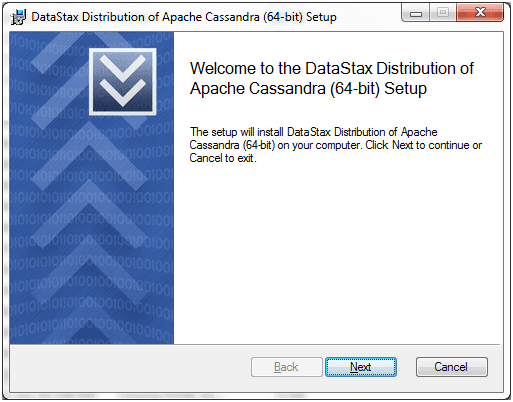
Click on the next button and you will get the following page:
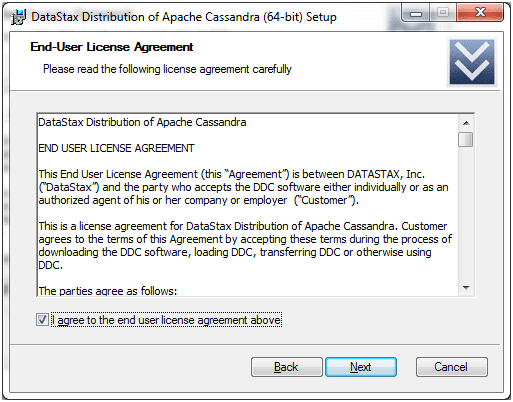
Press the next button and you will get the following page specifying the location of the installation.
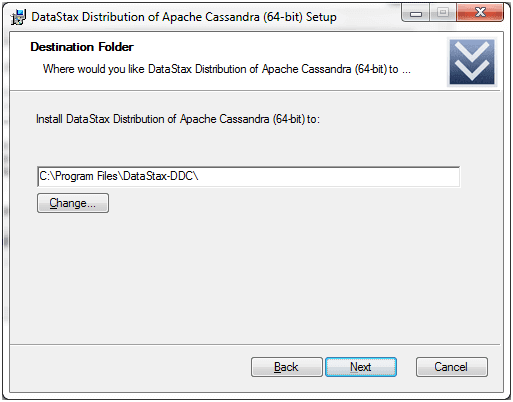
Press the next button and a page will appear asking about whether you automatically start Data Stax DDC service. Click on the radio button and proceed next.
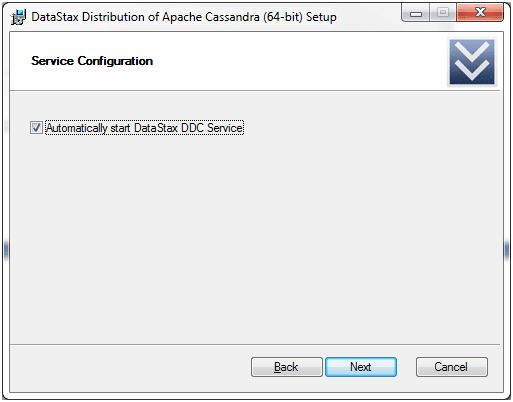
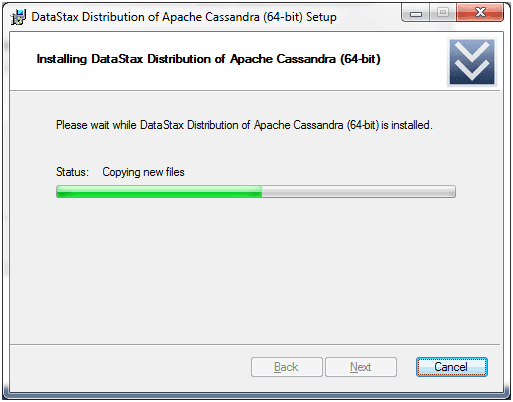
Installation is started now. After completing the installation, go to program files where Data Stax is installed.
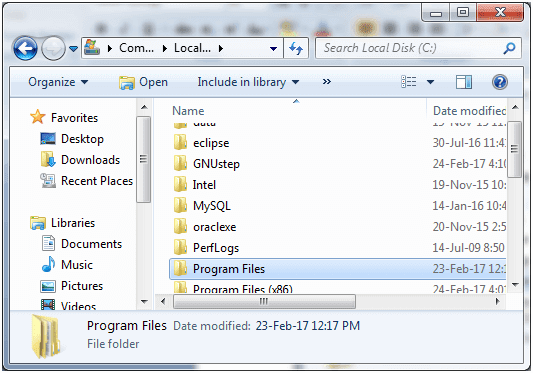
Open Program Files then you see the following page:
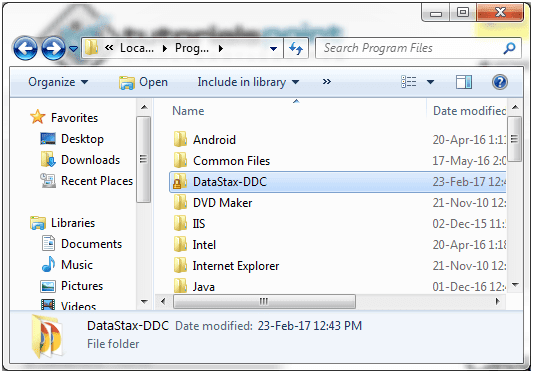
Open DataStax-DDC then you see Apache Cassandra:
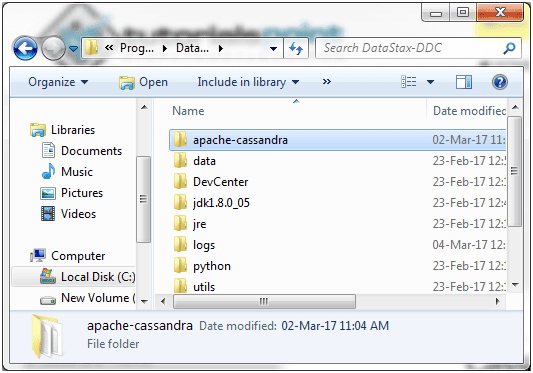
Open Apache Cassandra and you see bin:
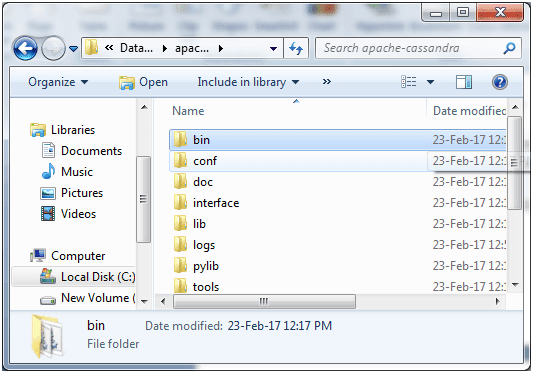
Open bin and you will see Cassandra Windows batch File:
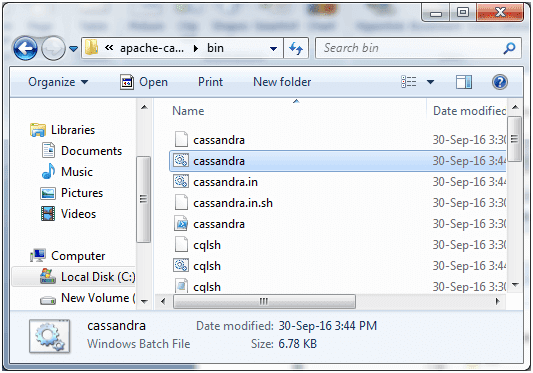
Run this file. It will start the Cassandra server and you will see the following page:
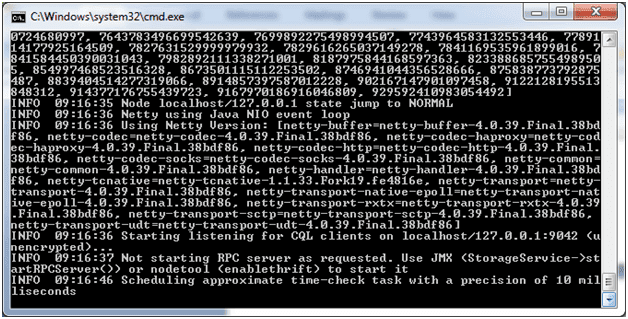
Server is started now go to windows start programs, search Cassandra CQL Shell
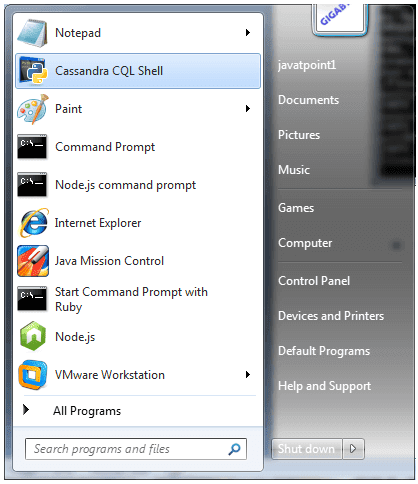
Run the Cassandra Shell. After running Cassandra shell, you will see the following command line:
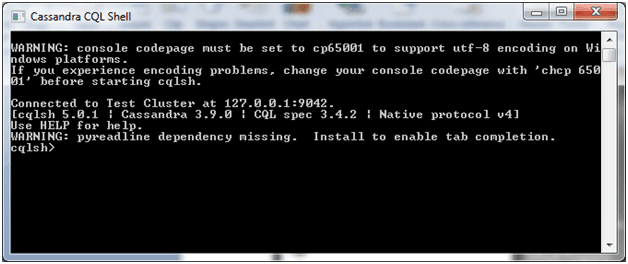
Are you looking training with Right Jobs?
Contact Us- Cassandra Vs MongoDB
- Apache Cassandra Architecture Tutorial
- Apache Cassandra Data Model Tutorial
- Apache Cassandra Interfaces Tutorial
- Cassandra Interview Questions and Answers
Related Articles
Popular Courses
- Postgresql Online Training
11025 Learners - Mongodb Training
12022 Learners - Amazon Dynamodb Training
11141 Learners
- What is Dimension Reduction? | Know the techniques
- Difference between Data Lake vs Data Warehouse: A Complete Guide For Beginners with Best Practices
- What is Dimension Reduction? | Know the techniques
- What does the Yield keyword do and How to use Yield in python ? [ OverView ]
- Agile Sprint Planning | Everything You Need to Know

